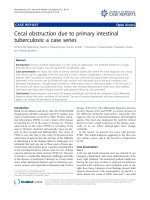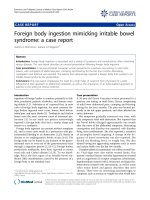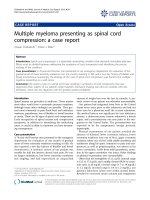Báo cáo y học: " Persistent alveolar soft-part sarcoma with liver metastasis: a case report" pps
Bạn đang xem bản rút gọn của tài liệu. Xem và tải ngay bản đầy đủ của tài liệu tại đây (716.07 KB, 4 trang )
CAS E REP O R T Open Access
Persistent alveolar soft-part sarcoma with liver
metastasis: a case report
Olugbenga A Silas
1*
, Adeyi A Adoga
2
, Agabus N Manasseh
1
, Godwin O Echejoh
1
, Raymond A Vhriterhire
1
,
Barnabas M Mandong
1
Abstract
Introduction: Alveolar soft-part sarcomas are rare, slow-growing tumors that metastasize commonly via vascular
routes to the lungs, bones, lymph nodes and brain, causing morbidity and mortality. To the best of our knowledge,
this is the first case describing metastasis to the liver reported from Nigeria.
Case presentation: A 57-year-old man of the Urhobo ethnic group of Nigeria presented with a persistent mass in
his left calf. It was initially diagnosed as soft-tissue sarcoma, and its associated systemic effects lead to his death
before a histological diagnosis could be obtained.
Conclusions: Alveolar soft-part sarcoma with metastasis to the liver can occur in our region (northeast Africa), and
a high index of suspicion is required to make an early diagnosis, followed by prompt surgical excision with clear
margins in order to prevent mortality.
Introduction
Alveolar soft-part sarcoma (ASPS) is an extremely rare,
vascular soft-tissue sarcoma affecting predominantly
adolescents and young adults [1].
Accounting for less than 1% of sof t tissue sarcomas,
ASPS occurs commonly in the lower extremities (44%)
and the head and neck (27%). Of the head and neck
cases, 25% occur in the tongue [2] and show a predilec-
tion for women.
Because it has close clinical and imaging resemblance
to common benign vascular tumors such as heman-
gioma, there is danger of misdiagnosis and, therefore,
inadequate or delayed treatment. ASPS often involves
the extremities of adolescents a nd young adults.
Although the origin of ASPS is still unknown, recent
cytogenetic studies revealed chromosomal rearrange-
ments at t(X;17)(p11;q25) resulting in the ASPL-TFE3
fusion gene. Because women have an extra X-chromo-
some, their likelihood of developing an X autosomal
translocation is theoretically double that of men. Thus,
this extra X-chromosome is a possible e xplanation for
the preponderance of ASPS in women [3,4].
Literature on ASPS is scant, especially in Nigeria and
neighboring countries. In work done by Mando ng et al.
ontheepidemiologyofsoft-tissuesarcomasinJos,
north central Nigeria, ASPS was found in only 3 (1.4%)
of the 216 soft-tissue sarcomas studied over a period of
10 years [5].
ASPS is a slow growing tumor, which runs an indolent
course with a poor prognosis, which metastasizes late to
the lungs, bones, lymph nodes and brain [6,7]. Metas-
tasis to the liver was reported in a large study of ASPS
in China [8]. We therefore present the first case of
ASPS with metastasis to the liver, with deleterious con-
sequences, in our region.
Our case shows the fast metastatic potential of this
tumor. Although it is most common among women and
in the young to early middle-age group, it can occur in
men into the sixth decade of life.
Because o f the rapidity of metastasis with consequent
mortality, a h igh index of suspicion is requir ed to make
a definitive diagnosis.
Case presentation
A 57-year-old man of the Urhobo ethnic group of
Nigeria presented to our hospital in January 2009 with
an eight-month history of a persistent l eft calf swe lling
and one-week history of generalized body swelling.
* Correspondence:
1
Department of Pathology, Jos University Teaching Hospital, PMB 2076, Jos,
Plateau State, Nigeria
Silas et al. Journal of Medical Case Reports 2010, 4:233
/>JOURNAL OF MEDICAL
CASE REPORTS
© 2010 Silas et al; licensee BioMed Central Ltd. This is an Open Access article distributed under the terms of the Creative Commons
Attribution License ( which permits unrestricted use, distribu tion, and reproduction in
any medium, provided the original work is prop erly cited.
He had already undergone an excision of the swelling in
another hospital five months prior to presentation,
although no histologic report or statement on the mar-
gins of excision were available from this hospital. The
swelling was recurred three weeks after the first excision
and our patient sought help for his condit ion from
traditional healers before presenting to our hospital.
The swell ing was tender and he had difficulty moving
his left leg. He was not diabetic or hypertensive. He had
no other swelling.
Examination r evealed a middle-aged man in painful
distress with a solitary lymph node in the left inguinal
region and non-pitting pedal edema in the affected limb.
There was a fungating mass measuring 6×8 cm on the
left calf. There was a wound with everted edges on the
mass, which was bleeding on contact.
Thesurgeonsmadeaprovisionaldiagnosisofrecur-
rent soft-tissue sarcoma. An abdominal ultrasound
showed multiple hepatic metastases about 3 cm in
greatest diameter. Random blood sugar (RBS) was 16.1
mmol/L, fasting blood sugar (FBS) was 10.6 mmol/L,
and packed cell volume (PCV) was 27%. Chest and left
leg X-rays were normal. Our patient could not afford a
computed tomography (CT) scan.
He was admitted, transfused with a unit of blood and
placed on subcutaneous soluble insulin, intravenous
ciprofloxacin, metronidazoleandibuprofentabletswith
daily wound dressing using Eusol.
One week later, the clinical condition of our patient
deteriorated and he died following efforts at resuscita-
tion. Surgeons delayed making a histological diagnosis.
The reason given was that our patient presented with
delirium and hyperglycemia, was thought to have dia-
betes m ellitus and was unfit for excision b iopsy. There-
fore, the physicians were asked to review and
metabolically stabilize our patient for surgery. The
pathologists were asked to review him two days before
his death, during which a biopsy of the leg swelling was
taken for histology. Because of the rapidity of events
leading to his death we were not able to obtain clinical
photographs of the site of the lesion.
Five days after his death, a histology report was
obtained as alveolar soft-part sarcoma with metastasis to
the liver. Our patient’ s relatives declined an autopsy.
Macroscopic features were a grayish-white tissue mea-
suring 2×3 cm with overlying skin and a tiny grayish-
whiteinguinalnodebiopsytissuepreservedin10%
formalin.
Microscopy showed oval to polygonal cells with eosi-
nophilic cytoplasm delineated by thin fibrovascular sep-
tae which separated the tumor cells into an organo id or
nest-like pattern of arrangement with evidence of vascu-
lar invasion (Figures 1 and 2). These features are consis-
tent with that of alveolar soft-part sarcoma.
Discussion
Sarcomas are rare malignant tumors, arising from con-
nective tissues and mostly found in the extremities [ 5],
with ASPS being an extremely rare, vascular soft-tissue
sarcoma affecting predominantly adolescents and young
adults [1].
It was first described as a separate disease entity in
1952 [9]. Accounting for less than 1% of soft -tissue sar-
comas, ASPS is commonly found in the lower extremi-
ties (44%) and in the head and neck (27%), with 25% of
head and neck cases occurring in the tongue [2].
Women are more predisposed t han men to ASPS. The
peak age incidence among patients is 15 to 35 years.
The pathogenesis of ASPS, as for most soft-tissue sarco-
mas, is unknown, although risk factors include irradia-
tion, genetic factors and chemical carcinogens [2].
Figure 1 Stratified squamous epithelium overlying a
fibrocollagenous stroma in which neoplastic cells arranged in
alveolar pattern are evident.
Figure 2 Sheets of neoplastic cells exhibiting hyperchromasia,
high nucleo-cytoplasmic ratio arranged in alveolar pattern by
thin fibrous strands.
Silas et al. Journal of Medical Case Reports 2010, 4:233
/>Page 2 of 4
ASPS is a slow-growing tumor, which runs an indo-
lent course with a poor prognosis , and metastasizes late
to the lungs, bones lymph nodes and brain [6,7]. Reports
of metastases to the liver were recorded in a large study
in China [8]. The following lesions should be considered
in the differential diagnosis of ASPS and they include
paraganglioma, rhabdomyosarcoma, renal-cell carci-
noma, metastatic adrenal carcinoma, clear-cell carci-
noma and melanoma. Unlike paragangliomas, the cell s
are frequently discohesive and lack nuclear pleomorph-
ism. Unlike alveolar RMS, the alveoli are not elongated
and are not separate d by fibrous tissue, and the cells are
much larger than primitive myocytes. The tumor may
closely resemble areas in renal-cell carcinoma, mela-
noma, metastatic adrenal carcinoma (often pleo-
morphic), and clear-cell sarcoma. The natural history of
ASPS can be prolonged [10].
Histologically, ASPS is characterized by the presence
of organoid nests of poly gonal tumor cells encompassed
by a dense capillary vasculature (Figures 1 and 2). The
name “alveol ar” was derived from its pseudo-alveolar
appearance with clustered polygonal cells lacking central
cohesion [11].
Recent cytogenetic studies show that ASPS exhibits a
conserved abnormality in the form of an unbalanced
translocation der(17)t(X;17)(p11;q25), which fuses the
N-terminal region of the alveolar soft-part locus gene
(ASPL), located at 17q25, to the C-terminal region of
the transcription factor E3 (TFE3), located at Xp11.
Two alternative fusion junctions have been observed
resulting in the expression of two distinct fusion tran-
scripts, ASPL-TFE3 type 1 and type 2 [2-4].
ASPS is a rare tumor. In a report on epidemiology of
soft-tissue sarcoma in Jos, Nigeria, Mandong et al.
observed that ASPS accounted for only 1.4% of total
soft-tissue sarcomas diagnosed over a period of 10 years
[5]. This is consistent with the low incidence recorded
among Nigerian Igbos by Onuigbo [12].
Reportsinotherpartsoftheworldhavealsoshow
that ASPS is rare and of unknown histogenesis. Joyama
et al. suggest that ASPS is a variant of rhabdomyosar-
coma [13].
Our patient had metastases to the liver presenting
with features of diabetes mellitus, the first such case
reported in Nigeria.
Although spontaneous regression has been reported
[14], surgical resecti on is the treatment of choice. How-
ever, the delay in making a definitive diagnosis led to
our patient’s death before he could benefit from this
treatment. Diagnosis by histology is paramount and
must be done immediately to institute definitive man-
agement, as ASPS has a high metastatic ability. A high
index of suspicion is necessary and techniques ensuring
fast histologic diagnosis, such as frozen section and
immunohistochemistry for proper typing of tumors, are
important. Unfortunately, our center does not have
these facilities.
Our case shows the ignorance of some health practi-
tioners, especially those in peripheral hospitals, about
the need for histologic reports of any mass excised from
a patient . Medical doctors in the developing world must
inculcate evidence-based medicine in t he management
of patients. The role of the pathologist in patient man-
agementcannotbeoveremphasizedastheincidenceof
cancers grad ually increases worldwide, includi ng Africa.
Although radiologic diagnosis maybe helpful, it may be
limited in the typing of tumors for effective tre atment.
Hospitals should therefore be equipped with histologic
and cytologic diagnostic tools for early detection of
malignancies and to reduce morbidity and mortality.
Conclusions
ASPS with metastasis to the liver d oes occur in Nigeria.
A high index of suspicion is required to make an early
diagnosis. After this, a pro mpt surgical excision with
clear margins should be done in order to avoid fatal
outcomes.
Consent
Written and informed consent for the publication of this
report and any accompanying images was obtained from
the daughter of ou r patient. A copy of the writt en con-
sent is available for review by the Editor-in-Chief of this
journal.
Acknowledgements
The authors thank the daughter of our patient for her consent for the
publication of this case report.
Author details
1
Department of Pathology, Jos University Teaching Hospital, PMB 2076, Jos,
Plateau State, Nigeria.
2
Department of Surgery, Jos University Teaching
Hospital, PMB 2076, Jos, Plateau State, Nigeria.
Authors’ contributions
OAS conceived the report and prepared the histologic slides and
manuscript. AAA performed the literature search and prepared the
manuscript. ANM read the slides. GOE reviewed the final manuscript. ARV
performed the literature search. BMM reviewed the final manuscript. All
authors have read and approved the final manuscript.
Competing interests
The authors declare that they have no competing interests.
Received: 21 September 2009 Accepted: 30 July 2010
Published: 30 July 2010
References
1. Stockwin LH, Vistica DT, Kenney S, Schrump DS, Butcher DO, Raffeld M,
Shoemaker RH: Gene expression profiling of alveolar soft-part sarcoma
(ASPS). BMC Cancer 2009, 9:22.
2. Rosai J, Ackerman LV: Soft tissue sarcoma. Ackerman’s surgical pathology
Mosby Company, 21989:1547-1618.
Silas et al. Journal of Medical Case Reports 2010, 4:233
/>Page 3 of 4
3. Daigeler A, Kuhnen C, Hauser J, Goertz O, Tilkorn D, Steinstraesser L,
Steinau HU, Lehnhardt N: Alveolar soft part sarcoma: clinicopathological
findings in a series of 11 cases. World J Surg Oncol 2008, 6:71.
4. Ladanyi M, Lui MY, Antonescu CR, et al: The der(17)t(X;17)(p11;q25) of
human alveolar soft part sarcoma fuses the TFE3 transcription factor
gene to ASPL, a novel gene at 17q25. Oncogene 2001, 20(1):48-57.
5. Mandong BM, Kidmas AT, Nanasseh AN: Epidemiology of soft tissue
sarcomas. Niger J Med 2007, 16(3):246-249.
6. Folpe AL, Deyrup AT: Alveolar soft-part sarcoma: a review and update. J
Clin Pathol 2006, 59:1127-1132.
7. Kayton ML, Meyers P, Wexler LH, Gerald WL, LaQuaglia MP: Clinical
presentation, treatment, and outcome of alveolar soft part sarcoma in
children, adolescents, and young adults. J Pediatr Surg 2006, 41:187-193.
8. Zhang RY: The histogenesis of alveolar soft part sarcoma: a
clinicopathological analysis of 135 cases. Zhonghua Bing Li Xue Za Zhi
1990, 19(3):165-168.
9. Christopherson WM, Foote FW Jr, Stewart FW: Alveolar softpart sarcoma:
structurally characteristic tumors of uncertain histogenesis. Cancer 1952,
5:100-111.
10. Rosai J, Ackerman LV: Soft tissues. Surgical Pathology New Delhi:Elsevier,
92004:2237-2330.
11. Lieberman PH, Brennan MF, Kimmel M, Erlandson RA, Garin-Chesa P,
Flehinger BY: Alveolar soft-part sarcoma. A clinico-pathologic study of
half a century. Cancer 1989, 63:1-13.
12. Onuigbo M: Adolescent breast masses in Nigerian Igbos. AMJ Surg 1979,
137(3):367-368.
13. Joyama S, Ueda T, Shimizu K, Kudawara I, Mano M, Funai H, Takemura K,
Yoshikawa H: Chromosome rearrangement at 17q25 and xp11.2 in
alveolar soft-part sarcoma. Cancer 1999, 86:1246-1250.
14. Banihani MN, Al Manasra AR: Spontaneous regression in alveolar soft part
sarcoma: case report and literature review. World J Surg Oncol 2009,
7(1):53.
doi:10.1186/1752-1947-4-233
Cite this article as: Silas et al.: Persistent alveolar soft-part sarcoma with
liver metastasis: a case report. Journal of Medical Case Reports 2010 4:233.
Submit your next manuscript to BioMed Central
and take full advantage of:
• Convenient online submission
• Thorough peer review
• No space constraints or color figure charges
• Immediate publication on acceptance
• Inclusion in PubMed, CAS, Scopus and Google Scholar
• Research which is freely available for redistribution
Submit your manuscript at
www.biomedcentral.com/submit
Silas et al. Journal of Medical Case Reports 2010, 4:233
/>Page 4 of 4









